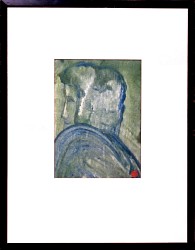

By Julia Sizek
Our dining room has been a wide open canvas in this giant house where I’ve been lucky to live for a year and a half. The room is one of the darkest in the house, a deep red color that the fast food industry would tell you makes you hungry. We would have never picked such a color, but it preceded us: the dining room, like the rest of the house, is owned by our landlords who are reoccupying the house this summer. When we gave our thirty days’ notice in advance of the impending move, I began taking down the prints in our dining room that we had to return to the library. I had borrowed two, as had one of my housemates. Each of them were beautiful, but the one that I spent the most time examining–mostly when I was pretending to write my dissertation, as I am also doing at this very moment–was “La Carpe” (“The Carp”) by Mario Avati. The print depicts a carp, its skeletal structure visible inside its fishy outline. One of the things that always vaguely upset me about the print is that the fish has no real eye, just a blank socket as one would expect in a skeleton. The blank eye circle is mirrored in the background, a horizontally pinstriped sheet with circular blots that look like carefully drawn circles from far away and water stains from close up. It’s fitting that the skeletal carp is surrounded by water circles, and it reminds me of one of the rules that they told us at the moment when they gave us the picture: don’t put it in the bathroom, they said. We agreed, and instead hung a cheap print of “St. Anthony Tempted by the Devil in the Form of a Woman” (Sausetta), a joke of sorts that we intended to leave to unsettle our bathroom users, a way to lighten the darkness of the house and the fact that it would never be ours.